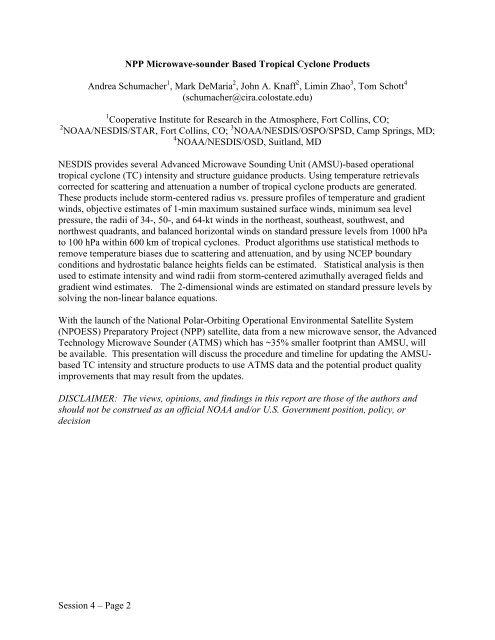65th IHC Booklet/Program (pdf - 4.9MB) - Office of the Federal ...
65th IHC Booklet/Program (pdf - 4.9MB) - Office of the Federal ...
65th IHC Booklet/Program (pdf - 4.9MB) - Office of the Federal ...
Create successful ePaper yourself
Turn your PDF publications into a flip-book with our unique Google optimized e-Paper software.
NPP Microwave-sounder Based Tropical Cyclone Products<br />
Andrea Schumacher 1 , Mark DeMaria 2 , John A. Knaff 2 , Limin Zhao 3 , Tom Schott 4<br />
(schumacher@cira.colostate.edu)<br />
1 Cooperative Institute for Research in <strong>the</strong> Atmosphere, Fort Collins, CO;<br />
2 NOAA/NESDIS/STAR, Fort Collins, CO; 3 NOAA/NESDIS/OSPO/SPSD, Camp Springs, MD;<br />
4 NOAA/NESDIS/OSD, Suitland, MD<br />
NESDIS provides several Advanced Microwave Sounding Unit (AMSU)-based operational<br />
tropical cyclone (TC) intensity and structure guidance products. Using temperature retrievals<br />
corrected for scattering and attenuation a number <strong>of</strong> tropical cyclone products are generated.<br />
These products include storm-centered radius vs. pressure pr<strong>of</strong>iles <strong>of</strong> temperature and gradient<br />
winds, objective estimates <strong>of</strong> 1-min maximum sustained surface winds, minimum sea level<br />
pressure, <strong>the</strong> radii <strong>of</strong> 34-, 50-, and 64-kt winds in <strong>the</strong> nor<strong>the</strong>ast, sou<strong>the</strong>ast, southwest, and<br />
northwest quadrants, and balanced horizontal winds on standard pressure levels from 1000 hPa<br />
to 100 hPa within 600 km <strong>of</strong> tropical cyclones. Product algorithms use statistical methods to<br />
remove temperature biases due to scattering and attenuation, and by using NCEP boundary<br />
conditions and hydrostatic balance heights fields can be estimated. Statistical analysis is <strong>the</strong>n<br />
used to estimate intensity and wind radii from storm-centered azimuthally averaged fields and<br />
gradient wind estimates. The 2-dimensional winds are estimated on standard pressure levels by<br />
solving <strong>the</strong> non-linear balance equations.<br />
With <strong>the</strong> launch <strong>of</strong> <strong>the</strong> National Polar-Orbiting Operational Environmental Satellite System<br />
(NPOESS) Preparatory Project (NPP) satellite, data from a new microwave sensor, <strong>the</strong> Advanced<br />
Technology Microwave Sounder (ATMS) which has ~35% smaller footprint than AMSU, will<br />
be available. This presentation will discuss <strong>the</strong> procedure and timeline for updating <strong>the</strong> AMSUbased<br />
TC intensity and structure products to use ATMS data and <strong>the</strong> potential product quality<br />
improvements that may result from <strong>the</strong> updates.<br />
DISCLAIMER: The views, opinions, and findings in this report are those <strong>of</strong> <strong>the</strong> authors and<br />
should not be construed as an <strong>of</strong>ficial NOAA and/or U.S. Government position, policy, or<br />
decision<br />
Session 4 – Page 2
















